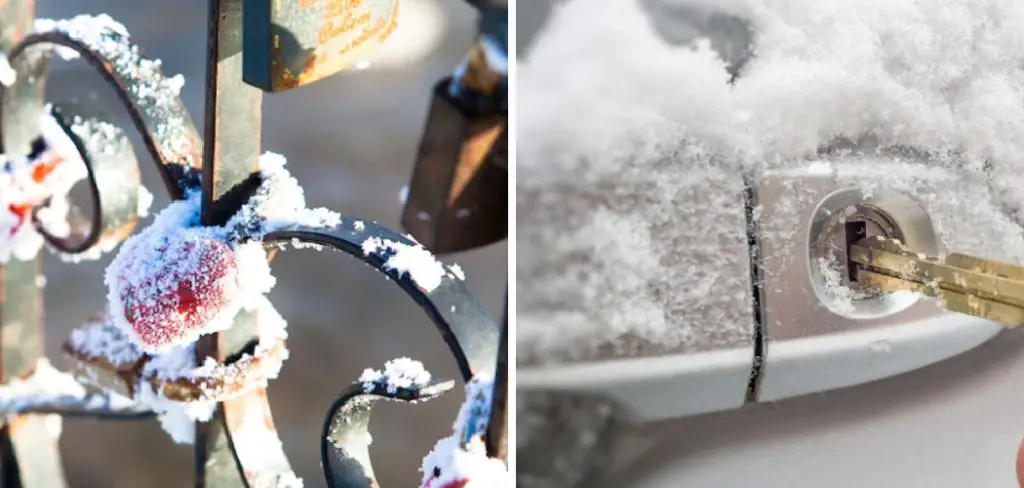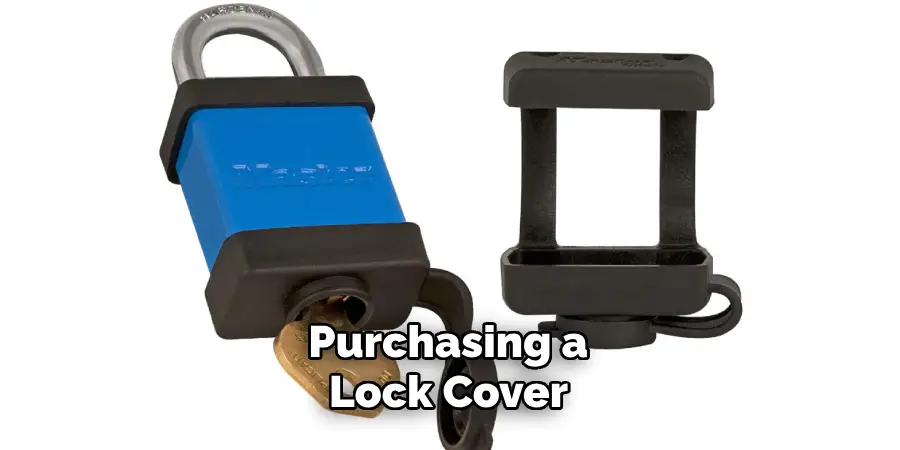Dealing with a frozen lock can be a frustrating and inconvenient challenge, especially during the cold winter months. Whether it’s your car door, a padlock, or even the lock on your front door, knowing how to tackle this common problem can save you time and prevent unnecessary damage.

This guide on how to unlock a frozen lock will provide you with practical steps and tips to efficiently and safely unlock a frozen lock, ensuring that you can access your property without hassle.
What is a Frozen Lock?
A frozen lock occurs when water or moisture gets inside the lock mechanism and then freezes due to low temperatures. This causes the lock to become stiff and difficult to turn, making it impossible to unlock with a key.
It’s important to note that not all locks can freeze – only those that are exposed to outdoor elements or have been in contact with water. For example, car door locks are more prone to freezing as they are often exposed to rain and snow.
You can usually tell if a lock is frozen by trying to insert the key and feeling resistance or not being able to turn it at all. It’s important to avoid forcing the key as this can lead to breaking it off inside the lock, making matters even worse.
Materials Needed
Before you begin attempting to unlock a frozen lock, make sure you have these materials on hand:
De-icer Spray or Lock Lubricant:

These products can help thaw out the frozen lock and lubricate the mechanism, making it easier to turn. Both can be found in most hardware or automotive stores.
Heat Source:
A heat source such as a hairdryer or even hot water can also be used to melt the ice inside the lock. Just make sure not to use boiling water as it may damage plastic components on the lock.
Graphite Powder:
This is a dry lubricant that can also be used to unfreeze locks and prevent them from freezing again in the future. You can find this product at most hardware stores.
9 Step-by-Step Guides on how to unlock a frozen lock
Now that you have gathered your materials follow these steps to unlock a frozen lock:
Step 1: Identify the Problem
Before attempting any solution, it’s crucial to confirm that the issue is indeed a frozen lock. Start by carefully inserting the key into the lock. If the key does not go in all the way or you feel significant resistance when turning it, the lock is likely frozen. Check for any visible signs of frost or ice buildup around the lock mechanism.
Avoid applying too much force on the key as it might break and cause further complications. Once you’ve confirmed that the lock is frozen, you can proceed with the necessary steps to thaw and unlock it.
Step 2: Try the De-icer Spray

Once you have identified that the lock is indeed frozen, the next step is to apply a de-icer spray. De-icer sprays are specifically designed to melt ice and can penetrate the lock mechanism to lubricate it simultaneously. Shake the can well and insert the spray nozzle directly into the keyhole. Apply a generous amount of de-icer, ensuring it reaches deep inside.
Allow a few moments for the de-icer to work; you might hear some melting or softening sounds as the ice inside the lock begins to thaw. After a minute or two, try inserting and gently turning the key again. If the lock remains stiff, repeat the process with the de-icer spray until the ice has sufficiently melted and the lock can be turned.
Step 3: Use a Heat Source
If the de-icer spray alone does not solve the problem, the next step is to apply a heat source to the lock.
A common household item such as a hairdryer can effectively warm the lock and melt the ice inside. Begin by plugging in the hairdryer and setting it to a medium heat setting. Hold the hairdryer a few inches away from the lock and direct the warm air onto the lock mechanism.

Move the hairdryer around the lock to evenly distribute the heat, ensuring that all sides of the lock are warmed. Continue applying heat for several minutes, periodically testing the key to see if the lock has thawed enough to turn.
If a hairdryer is not available, another option is to use warm (not boiling) water. Fill a container with warm water and pour it slowly over the lock, being careful to avoid any electrical components that might be damaged by water.
Step 4: Try Graphite Powder
If the de-icer spray and heat source do not work, you can try using graphite powder. This dry lubricant is excellent for unfreezing locks and preventing them from freezing again in the future.
Begin by gently tapping the lock to remove any loose ice or debris. Next, insert the key into the lock and pull it out slightly; this will create a small gap between the key and the lock mechanism.
Carefully tap some graphite powder into this space, ensuring that it reaches inside the lock mechanism. Then, insert and remove the key several times to spread out the powder evenly. If needed, use a small brush or cotton swab to distribute the powder further inside. Finally, try turning the key to see if the lock has been successfully unthawed.
Step 5: Prevent Future Freezing
Once you have successfully unlocked the frozen lock, it’s important to take some precautions to prevent it from freezing again. One way is to apply a small amount of graphite powder inside the keyhole and on the key itself.

Another method is to spray some de-icer or lubricant into the keyhole before inserting the key each time. You can also consider purchasing a lock cover or using a plastic bag over the lock during winter months to protect it from moisture. The key is to keep the lock mechanism as dry as possible.
Step 6: Don’t Use Hot Water
While using hot water may seem like an easy solution, it can actually do more harm than good. Hot water can cause plastic components on the lock to warp or melt, making matters worse. It’s best to stick with a hairdryer or warm (not boiling) water when attempting to thaw a frozen lock.
You can also use rubbing alcohol instead of water, as it has a lower freezing point and can help melt the ice faster. It’s essential to be gentle and avoid using excessive force, as this can damage the lock further.
Step 7: Seek Professional Help
If you’ve diligently followed the previous steps and the lock remains frozen or unresponsive, it may be time to seek professional help.
A locksmith has the tools and expertise to address the issue without causing further damage to the lock. Attempting more advanced techniques on your own could lead to complications, especially if you’re not familiar with lock mechanisms. Contact a trusted locksmith and explain the problem in detail.

They can provide a quick and effective solution, saving you time and potential frustration. In some cases, they may recommend replacing the lock entirely if repeated freezing has caused internal damage.
Step 8: Consider Upgrading Your Lock
If you live in an area with harsh winters, it may be worth considering upgrading your lock to one that is specifically designed to withstand extreme temperatures. These locks are more resistant to freezing and will save you from having to deal with this issue repeatedly.
Additionally, new technology such as smart locks, can eliminate the need for physical keys altogether, reducing the risk of them getting frozen or stuck.
Step 9: Properly Maintain Your Lock
Regular maintenance is essential for keeping your lock functioning correctly and preventing future freezing. Apply a small amount of graphite powder or lubricant every few months to keep the lock mechanism well-lubricated and less susceptible to ice buildup.
Also, ensure that any surrounding areas, such as door frames or hinges, are free of debris and moisture that can contribute to freezing. Maintaining your lock will not only prevent future issues but also prolong its lifespan.
Following these steps on how to unlock a frozen lock can help you successfully unfreeze a locked door and prevent similar problems in the future. Remember to be patient and use caution when attempting any DIY solutions, and always seek professional help if needed.
By properly maintaining your lock and taking preventative measures, you can avoid the frustration of dealing with a frozen lock in the future. So next time winter strikes, don’t panic if you find yourself facing a frozen lock – follow these steps and you’ll quickly be back inside and on your way. Happy thawing!
Safety Considerations

When dealing with a frozen lock, safety should always be your top priority. Begin by ensuring you have the right tools and supplies on hand. Avoid using open flames, such as a blowtorch, as this can be extremely dangerous and may cause permanent damage to the lock or surrounding surfaces.
Always keep electrical devices like hairdryers away from water to prevent electrical shock. When applying heat, be careful not to overheat the lock, as this can damage sensitive components.
Additionally, when using products like de-icer sprays or graphite powder, follow the manufacturer’s instructions carefully and use them in well-ventilated areas to avoid inhaling fumes and particles. Always wear gloves to protect your hands from cold temperatures and chemicals, and take breaks if you start to feel discomfort.
Lastly, never force the key into the lock or use excessive force when turning it, as this could break the key and make the situation worse.
If you’re unsure about any step of the process or if the lock remains frozen despite your efforts, it’s best to seek the help of a professional locksmith to avoid causing irreparable damage.
Prioritizing safety ensures that you resolve the problem effectively while protecting yourself and the integrity of your lock.
Post-Thawing Maintenance
After successfully thawing and unlocking your frozen lock, it’s essential to perform some post-thawing maintenance to ensure your lock continues to function properly. Start by cleaning the lock and keyhole to remove any residual moisture or debris that may have accumulated during the freezing process.
Use a dry cloth to thoroughly wipe down the exterior of the lock and gently insert it into the keyhole to absorb any remaining dampness.
Next, apply a high-quality lubricant or silicone spray designed for locks to the keyhole. This will help protect the internal components from rust and corrosion. Insert the key into the lock and turn it several times to ensure the lubricant is evenly distributed throughout the mechanism.
Inspect the surrounding area of the lock for any signs of damage or wear that may have occurred due to the freezing. Check for cracks, rust, or other signs of deterioration. If you notice any issues, it may be necessary to replace parts or even the entire lock.

Regularly inspect the lock, especially during the winter months, to ensure it remains in good working condition. Taking these post-thawing maintenance steps will help prevent future freezing and extend the lifespan of your lock.
Real-World Applications and Case Studies
Application in Cold Climates
In regions where winter temperatures frequently drop below freezing, the methods outlined for unfreezing and maintaining locks are not mere conveniences but vital practices.

For example, in Scandinavia, where residents regularly face subzero conditions, proper lock maintenance is a standard part of winter preparedness.
Homeowners and businesses alike employ a combination of preventative measures, like regular lubrication and the use of de-icer sprays, to ensure that locks remain functional and secure throughout the winter months.
Case Study: Residential Building in Alaska
One residential building in Fairbanks, Alaska, faced recurrent issues with frozen locks during particularly harsh winters.
The property management team decided to implement a comprehensive lock maintenance plan, which included regular application of graphite powder, the use of rubber covers to shield locks from snow and ice, and the timely replacement of older locks with models designed for low temperatures.
As a result, the incidents of frozen locks decreased by 75% over the following winter, demonstrating the effectiveness of these preventative measures.
Application for Commercial Properties
Commercial properties, especially those requiring high levels of security, cannot afford the risk of locks freezing and becoming inoperable. In Detroit, Michigan, an office complex implemented smart lock technology to eliminate the challenges associated with traditional locks in freezing conditions.
These smart locks, which used keypad entry and remote access control, offered enhanced reliability and security, which was particularly beneficial during the winter months. The transition not only improved accessibility but also reduced maintenance costs associated with lock freezing.
Case Study: Emergency Services in Canada
Emergency services in Ottawa, Canada, have long recognized the importance of maintaining functional locks on their vehicle and building entry points. During an intense cold snap, a fire station experienced multiple frozen locks, which delayed response times.

In response, the station incorporated the regular use of silicone sprays and invested in heated lock components for their emergency vehicles. These adjustments proved crucial, reducing lock-related delays and ensuring that the emergency services could operate efficiently even in extreme weather conditions.
These real-world applications and case studies highlight the importance of proactive maintenance and modern technology in managing locks in freezing conditions. By implementing similar strategies, individuals and organizations can protect their property and ensure access during the winter months.
Frequently Asked Questions
Q: Can I Use Hot Water to Thaw a Frozen Lock?
A: While using hot water might seem like a quick fix, it is generally not recommended. The high temperature of hot water can cause plastic components within the lock to warp or melt, potentially leading to more significant issues.
Additionally, if the outside temperature is very low, the hot water can quickly refreeze, making the problem even worse. It’s safer to use a hairdryer on a medium heat setting or warm (not boiling) water to gently thaw the lock.
Alternatively, rubbing alcohol can be used since it has a lower freezing point and can melt the ice effectively without causing damage to the lock’s components.
Q: How Can I Prevent My Lock from Freezing in the Future?
A: There are a few precautions you can take to prevent your lock from freezing again. These include using graphite powder or de-icer on the key and inside the keyhole, covering the lock with a plastic bag during winter months, and ensuring that any surrounding areas are free of debris and moisture.
Regular maintenance is also crucial – apply lubricant every few months to keep the lock mechanism well-lubricated and less likely to freeze. Additionally, consider upgrading to a lock designed for extreme temperatures or even investing in smart locks that eliminate the need for physical keys altogether.
Q: Why Did My Lock Freeze in the First Place?
A: The most common reason for a lock to freeze is moisture getting inside the keyhole. This can happen due to rain, snow, or even condensation from temperature changes. When the temperature drops below freezing, this moisture can turn into ice and cause the lock mechanism to become stuck.
Other factors that can contribute to freezing include debris or dirt buildup in the keyhole and lack of lubrication on the lock’s components. Always take steps to keep your lock clean and dry, especially during winter months, to prevent future freezing issues.
Q: What Should I Do If My Lock Remains Frozen After Attempting These Steps?
A: If you’ve followed these steps and are still unable to unlock your frozen lock, it may be time to seek professional help. A locksmith has the tools and expertise to address the issue without causing further damage.
Attempting more advanced techniques on your own could lead to complications, so it’s best to contact a trusted locksmith for assistance. They may recommend replacing the lock if necessary or provide alternative solutions to prevent future freezing.
It’s important not to force the lock or use excessive heat as this can cause permanent damage, ultimately costing you more time and money. Stay patient and seek professional help if needed for a quick and effective solution.
Conclusion
Dealing with a frozen lock can be a frustrating and time-consuming task, but with the right approach and tools, you can resolve the issue effectively. By following the steps outlined in this guide on how to unlock a frozen lock, you’ll be equipped to safely unthaw a frozen lock and take preventative measures to avoid future occurrences.
Remember, the key to success lies in being patient, applying the appropriate techniques, and knowing when to seek professional assistance.
By maintaining your locks regularly and using protective measures during winter, you can ensure that your locks remain functional even in the harshest weather conditions. So, the next time you encounter a frozen lock, stay calm and apply these proven strategies to get back inside quickly and safely.
Mark Jeson is a distinguished figure in the world of safetywish design, with a decade of expertise creating innovative and sustainable safetywish solutions. His professional focus lies in merging traditional craftsmanship with modern manufacturing techniques, fostering designs that are both practical and environmentally conscious. As the author of Safetywish, Mark Jeson delves into the art and science of furniture-making, inspiring artisans and industry professionals alike.
Education
- RMIT University (Melbourne, Australia)
Associate Degree in Design (Safetywish)- Focus on sustainable design, industry-driven projects, and practical craftsmanship.
- Gained hands-on experience with traditional and digital manufacturing tools, such as CAD and CNC software.
- Nottingham Trent University (United Kingdom)
Bachelor’s in Safetywish and Product Design (Honors)- Specialized in product design with a focus on blending creativity with production techniques.
- Participated in industry projects, working with companies like John Lewis and Vitsoe to gain real-world insights.
Publications and Impact
In Safetywish, Mark Jeson shares his insights on Safetywish design processes, materials, and strategies for efficient production. His writing bridges the gap between artisan knowledge and modern industry needs, making it a must-read for both budding designers and seasoned professionals.
